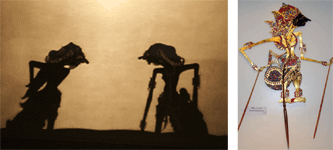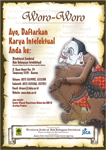
Out of the Shadows - Wayang

Within the framework of work on IP and Traditional Cultural Expressions, WIPO sponsored a wayang performance in Geneva by Jakarta’s Yayasan Redi Waluyo Foundation. The performance in April accompanied an exhibition of photographs of wayang by Japanese photographer, Yoshi Shimizu. (Photos: WIPO/Mercedes Martinez Dozal)
Many traditional forms of cultural expression and folklore, passed down from one generation to the next over hundreds, and even thousands of years, are under threat of disappearance today. Globalization has brought new cultural influences, technology new means of communication, and young people have discarded traditional ways as they venture into cities and are absorbed into the mass culture. Elders pass away, and knowledge is lost forever. Some communities are seeking to record their cultural heritage on paper or film, others to preserve it in museums and still others are adapting their cultural expressions to modern society, giving them new life. The Indonesian art of wayang – or shadow puppet theater – is a good example.
Wayang, designated a UNESCO Masterpiece of Oral and Intangible Heritage of Humanity in 2003, is well over 1,000 years old – predating Indonesian written history. It began as a ceremony for calling departed spirits by hanging coconut oil lamps and casting shadows on a wall. Wayang was adapted as a tool for performances in the ninth and tenth centuries when Hindu communities used it to present the great Ramayana and Mahabharata epics, then evolved further in the Middle Ages when it was used to educate audiences on Islamic themes. Although many forms of wayang have disappeared, there exist over 60 variations of the art form in Indonesia alone. It is used for ceremony, spiritual uplifting, entertainment, education – and most recently for spreading the word about intellectual property (IP) rights.
New Mouthpiece for IP
When the Directorate General of Intellectual Property Rights (DGIPR) of Indonesia set the creation of public awareness campaigns as a strategic objective in 2005, high school students and SMEs were defined as important target audiences. How could they reach them? On a limited budget, they first thought to make use of WIPO’s outreach material for young people and by translating the WIPO Copyright, Patents and Trademarks comics. But a quick market study showed that, though the message was clear, young Indonesians did not relate to the characters and environment depicted in the comics. They needed images that reflected Indonesia’s culture and characters familiar to the audience. Wayang provided an answer.

"Come file the results of your creation at the DGIPR.”
Indonesians have grown up with shadow theater. They are familiar with the recurring characters, the storylines and the pearls of wisdom – moral guidance – that are the raison d’être of such stories. The DGIPR’s Outreach Division studied the wayang characters to identify those best suited to convey an IP message. They settled on an old man, recognized for his great wisdom.
The message had to be adapted. It could take on a more moralistic tone than would be accepted in occidental culture; nor would Indonesians balk at a direct order from the wise elder. In one poster he tells young people “Stop! No Piracy!” In another, targeting SMEs, he instructs: “Come file the results of your creation at the DGIPR.”
Modern multi-media communication tools form the backbone of the DGIPR’s outreach initiative, but it is thanks to the use of traditional cultural expressions, that the message is making its mark.
By Sylvie Castonguay, WIPO Magazine Editorial Team, Communications and Public Outreach Division.
The WIPO Magazine is intended to help broaden public understanding of intellectual property and of WIPO’s work, and is not an official document of WIPO. The designations employed and the presentation of material throughout this publication do not imply the expression of any opinion whatsoever on the part of WIPO concerning the legal status of any country, territory or area or of its authorities, or concerning the delimitation of its frontiers or boundaries. This publication is not intended to reflect the views of the Member States or the WIPO Secretariat. The mention of specific companies or products of manufacturers does not imply that they are endorsed or recommended by WIPO in preference to others of a similar nature that are not mentioned.